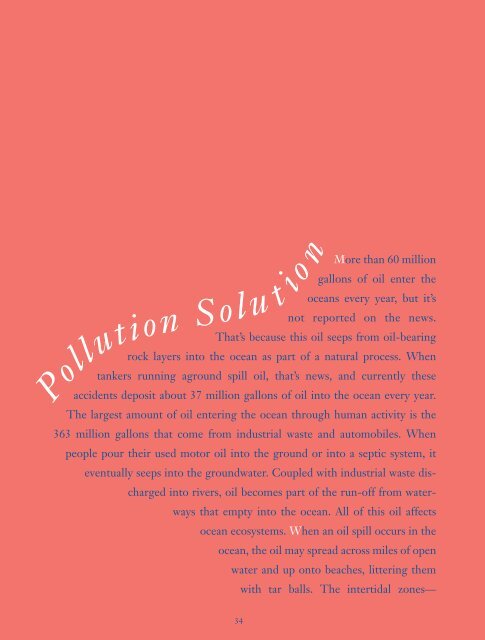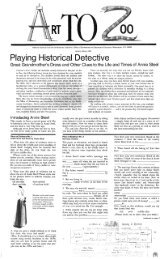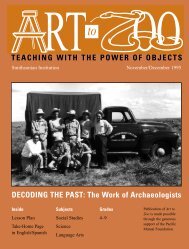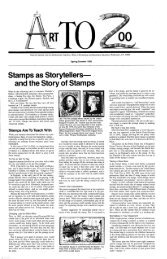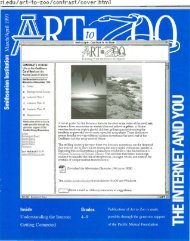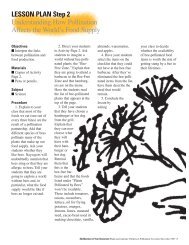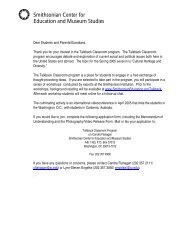Pollution Solution - Smithsonian Education
Pollution Solution - Smithsonian Education
Pollution Solution - Smithsonian Education
You also want an ePaper? Increase the reach of your titles
YUMPU automatically turns print PDFs into web optimized ePapers that Google loves.
34<br />
More than 60 million<br />
gallons of oil enter the<br />
oceans every year, but it’s<br />
not reported on the news.<br />
That’s because this oil seeps from oil-bearing<br />
rock layers into the ocean as part of a natural process. When<br />
tankers running aground spill oil, that’s news, and currently these<br />
<strong>Pollution</strong> Solu t io n<br />
accidents deposit about 37 million gallons of oil into the ocean every year.<br />
The largest amount of oil entering the ocean through human activity is the<br />
363 million gallons that come from industrial waste and automobiles. When<br />
people pour their used motor oil into the ground or into a septic system, it<br />
eventually seeps into the groundwater. Coupled with industrial waste dis-<br />
charged into rivers, oil becomes part of the run-off from water-<br />
ways that empty into the ocean. All of this oil affects<br />
ocean ecosystems. When an oil spill occurs in the<br />
ocean, the oil may spread across miles of open<br />
water and up onto beaches, littering them<br />
with tar balls. The intertidal zones—
35<br />
coastal areas that are the<br />
habitat for fish, birds, and<br />
other wildlife—are often the<br />
most vulnerable. Animals may perish<br />
when the oil slicks their fur or downy<br />
feathers, decreasing the surface area so they are no<br />
longer insulated from the cold water. Or the animals may ingest the oil, then<br />
become sick or unable to reproduce properly. When an oil spill occurs along a<br />
coastline, it affects the human population as well as wildlife. Emergency equipment<br />
and personnel must be rushed to the scene. The responsible party must be identi-<br />
fied to determine who will pay for the cleanup. Usually the cleanup is a group effort<br />
by oil companies, government agencies, local groups, and volunteers. People rescue<br />
and clean birds and animals and painstakingly scrub the oil from the rocky shores<br />
with brushes and detergent. Coming in by sea and by air, crews skim the spreading<br />
oil from the water’s surface. Oil that cannot be skimmed is emulsified—that is,<br />
droplets of oil are scattered into tiny particles that will then float away and disperse<br />
out to sea. Sometimes microscopic helpers are put to work. Genetic engineers have<br />
developed oil-eating bacteria that can be used to ingest the oil, to clean up long<br />
after the crews and volunteers have left. The experience gained from several well-<br />
publicized oil spills has ushered in an era of greater understanding and internation-<br />
al cooperation with regard to containing spills and avoiding environmental disasters<br />
that affect our global ocean. One bright spot of news is that ecologists revisiting oil<br />
spill sites have found marine population recovery better than they had predicted.
<strong>Pollution</strong> Solu t io n<br />
Les s o n Plan<br />
Obje c t i v es<br />
Mate r ia l s<br />
Predict the effects of an oil spill on a marine<br />
environment.<br />
Establish a list of solutions to avoid unnecessary<br />
oil pollution.<br />
Copies of Student Page A<br />
Optional: additional photographs or articles<br />
about oil spills<br />
biology, chemistry, social studies<br />
36<br />
Step 1<br />
Subjects
Procedu r e<br />
1. Introduce the topic of oil<br />
pollution and how it affects the<br />
global ocean. Make a pie chart to<br />
show the actual small percentage<br />
of oil (5 percent) that enters the<br />
ocean through oil spills. Then<br />
discuss oil spills with which<br />
students may be familiar, such as<br />
the spill off the coast of Rhode<br />
Island in January 1996 and the<br />
one in Prince William Sound in<br />
Alaska in 1989. You may wish to<br />
check your library or online<br />
sources for magazine and<br />
newspaper articles about actual<br />
oil spill events, perhaps an<br />
incident that occurred close to<br />
your region to make the topic<br />
more relevant to students.<br />
2. Explain to students that crude<br />
oil is taken directly from its rocky<br />
source below ground or under<br />
the sea. It is often transported in<br />
huge tankers across vast distances<br />
to oil refineries. There the crude<br />
is distilled and refined into many<br />
familiar petroleum products.<br />
During the distillation process,<br />
petroleum is heated to extremely<br />
high temperatures to separate it<br />
into various components such as<br />
gasoline and kerosene. Students<br />
may not know that petroleum is<br />
used for waxes contained in<br />
petroleum jelly, lipstick, and many<br />
personal care products. Each of<br />
these petroleum products has<br />
different chemical characteristics.<br />
In general, the molecules that<br />
make up oils and waxes adhere<br />
to one another and are less dense<br />
than water; thus, they float on the<br />
water’s surface without mixing.<br />
However, the currents and wind<br />
out on the open ocean cause the<br />
oil in an oil spill to spread and<br />
travel away from the spill site.<br />
3. After an initial discussion,<br />
hand out Student Page A. In<br />
this page students can use<br />
problem-solving skills to decide<br />
what strategies they would use if<br />
they were actually cleaning up an<br />
oil spill. They can work in small<br />
groups and brainstorm to come<br />
up with answers cooperatively.<br />
37<br />
Possible answers,<br />
page 38:<br />
1. Problems: Currents and<br />
wind may carry the oil over<br />
a huge area of the sea.<br />
Strategies: Bring in equipment<br />
by air or boat to skim<br />
the oil from the water’s<br />
surface before it spreads.<br />
Problems: Rocks will get<br />
covered with oil; animal<br />
habitats will be harmed.<br />
Strategies: Have crews<br />
scrub the rocks with<br />
brushes and detergent.<br />
Problems: The oil will<br />
wash up on shore, making<br />
cleanup difficult and<br />
affecting wildlife.<br />
Strategies: Have crews take<br />
away or sift through oily<br />
sand and rescue wildlife.<br />
2. These agencies have<br />
information about winds,<br />
currents, tides, and<br />
weather patterns affecting<br />
the area.<br />
This agency has<br />
information about which<br />
species of fish and wildlife<br />
need protection.<br />
3. Water is denser, so oil<br />
floats on it.<br />
4. The oil will probably<br />
spread out away from the<br />
spill, staying on top of the<br />
water rather than sinking.
<strong>Pollution</strong> Solu t io n<br />
Suppose you are in the business of cleaning up<br />
oil spills in the ocean. Your team has just received word of a tanker leaking oil in<br />
the Pacific Ocean. How will you use your resources to effectively clean up the oil and<br />
prevent it from spreading? Brainstorm in a small group to predict what will happen<br />
during the oil spill, then plan your cleanup strategies.<br />
1. What special problems arise if an oil spill occurs in the open ocean, on a rocky coast, or near a sandy<br />
beach? (Hint: You might think about things like currents, surface area, and habitat for wildlife.) List the<br />
kinds of equipment and vehicles you might need to do the cleanup at each site in the data chart below.<br />
Oil Spill Site Special Problems Possible Strategies for Cleanup<br />
Open ocean<br />
Rocky coast<br />
Sandy beach<br />
2. What kind of information would be important to find out from these government services?<br />
Weather Service or Coast Guard<br />
U.S. Fish and Wildlife Service<br />
3. Which do you think is denser, oil or water?<br />
4. What do you think will happen to the oil (or other petroleum product) as it spills out of a<br />
tanker into the ocean?<br />
Studen t P age A<br />
38
<strong>Pollution</strong> Solu t io n<br />
Les s o n Plan<br />
Make a model of an ocean oil spill.<br />
Evaluate the efficiency of oil spill cleanup methods.<br />
Mate r ia l s<br />
For each group of four students, a shallow oblong<br />
pan, water, vegetable oil, cotton balls, teaspoon,<br />
medicine dropper, timer, plastic container for wastewater,<br />
and plastic bag for discarded cotton balls.<br />
Student Page B<br />
Optional: liquid detergent, brush, bird feather, wire<br />
whisk, pebbles<br />
physics, mathematics<br />
39<br />
Obje c t i v es<br />
Subjects<br />
Step 2
Procedu r e<br />
1. Advise students of the activity<br />
the day before so they can wear<br />
washable clothing. Divide students<br />
into groups of four. Each<br />
group can carry out the simulated<br />
oil spill and cleanup cooperatively.<br />
Arrange to have all the materials<br />
students need at each workstation.<br />
Guide students as they read<br />
through the directions on how to<br />
make an oil spill and then clean it<br />
up. Advise them to use their<br />
resources wisely, as they will be<br />
“charged” for each piece of equipment<br />
and the disposal of the oil.<br />
2. In carrying out the activity,<br />
limit the “disaster” to a portion of<br />
the classroom or lab where surfaces<br />
can be wiped dry. Use clear<br />
plastic bags to collect the oilsoaked<br />
cotton balls so that students<br />
can count them and be<br />
charged accordingly. Use quart-<br />
sized, wide-mouthed plastic<br />
containers for the wastewater,<br />
which can then be carried to a<br />
sink for disposal. Have paper<br />
towels on hand to clean up spilled<br />
water and advise students of<br />
slippery floors.<br />
3. Options: Before students begin,<br />
demonstrate that “oil and water<br />
don’t mix” by pouring some oil<br />
into a clear container of water.<br />
Have students observe how the<br />
oil forms a layer on top of the<br />
water. Then use a wire whisk to<br />
stir up the oil and water. Students<br />
will see how oil can be made into<br />
smaller and smaller droplets that<br />
will disperse in the open ocean<br />
where there is room to spread<br />
out. This is similar to one of the<br />
techniques used in cleanup operations.<br />
If students use the whisk in<br />
their pans, it will make skimming<br />
the oil much more difficult, but<br />
you might challenge some<br />
students to do it anyway. Another<br />
interesting demonstration is to<br />
dip a bird feather in oily water<br />
and have students try to clean the<br />
feather using liquid detergent and<br />
a brush.You can also challenge<br />
one group to simulate an oil spill<br />
that hits a rocky coast by using<br />
pebbles at one end of the pan.<br />
40<br />
Have students compare the<br />
amount of surface area for that<br />
cleanup with an oil spill on the<br />
open ocean.<br />
4. After the groups have worked<br />
on their oil spills for twenty<br />
minutes, have them tally the cost<br />
of their efforts and clean up their<br />
spill sites. Students can then<br />
answer the discussion questions<br />
and compare their results.
<strong>Pollution</strong> Solu t io n<br />
In this activity you will make your own “ocean”<br />
in a pan of water. You can simulate your own very limited environmental disaster—<br />
and then clean it up! Work with your group to set up the materials shown below.<br />
<strong>Pollution</strong> <strong>Solution</strong> Cost Sheet<br />
Equipment and Techniques Cost Minutes of Use Total Cost<br />
or Number Used<br />
Medicine dropper “skimmer” $100/minute<br />
Cotton ball $20/piece<br />
Waste disposal:<br />
Discarded cotton ball $50/each<br />
Container for wastewater $1,000/each<br />
Labor $1,000/person/minute<br />
Total cost<br />
Studen t P age B<br />
1. Use the shallow pan filled<br />
halfway with water as your<br />
model ocean. Add a teaspoon<br />
of vegetable oil to the middle<br />
of the pan to simulate a<br />
leaking oil tanker.<br />
2. While one group member<br />
releases the oil in the center of<br />
your ocean, another begins timing.<br />
3. After one minute has passed,<br />
observe what happens to the oil.<br />
See how the oil is affected as<br />
another team member blows on<br />
the oil, simulating the wind.<br />
41<br />
4. Begin the cleanup of the oil<br />
using the available materials.<br />
You may take twenty minutes.<br />
5. Try to do the cleanup<br />
efficiently because you will be<br />
“charged” for the use of each<br />
piece of equipment. No cleanup<br />
effort is free! Keep track of the<br />
time each technique is used.<br />
Use the chart below to calculate<br />
the cost of your efforts.
<strong>Pollution</strong> Solu t io n<br />
Use the back of this page or<br />
a separate sheet to answer<br />
these discussion questions.<br />
1. Did you clean up your oil spill within twenty minutes? Did everyone agree on how<br />
clean the pan was?<br />
2. Which technique seemed to work best?<br />
Studen t P age B<br />
3. Make a chart of your class results. Which group cleaned its ocean at the lowest price?<br />
4. What importance does immediate response have in cleanup efforts?<br />
5. Suppose class members used different kinds of oil. Would their results be the same?<br />
Do you think all petroleum spills behave the way vegetable oil does? Why or why not?<br />
42
<strong>Pollution</strong> Solu t io n<br />
Les s o n Plan<br />
Identify the problems caused to the environment<br />
and society by an oil spill and the subsequent<br />
cleanup operations.<br />
Mate r ia l s<br />
List of fictitious characters (on page 44)<br />
Optional: newspaper or magazine articles about<br />
oil spills<br />
social studies, language arts<br />
43<br />
Step 3<br />
Obje c t i v es<br />
Subjects
Procedu r e<br />
1. To get a sense of the impact of<br />
an oil spill, have a role-playing<br />
discussion. Ask students to play<br />
the parts of some or all of the<br />
fictitious characters listed here.<br />
Have each character write some<br />
notes that would be taken to a<br />
press conference held to find out<br />
what happened when a tanker<br />
went aground and caused an oil<br />
spill along a coastline. Some<br />
members of the class can be<br />
reporters, directing questions to<br />
any of the participants. Other<br />
members of the class can record<br />
the discussion in writing or<br />
videotape it.<br />
Fictitious characters<br />
Captain Shipley: captain of the<br />
tanker that went aground<br />
Ms. Petrol: spokesperson for the<br />
Giant Oil Corporation<br />
Mr. Swab: head of cleanup<br />
operations<br />
Ms. Cirrus: spokesperson for the<br />
U.S. Weather Service<br />
Mr. Marchand: president of the<br />
local merchants’ association<br />
Ms. Greene: spokesperson for a<br />
national conservation group<br />
Mr. Hook: spokesperson for the<br />
local fishing community<br />
Ms. Wright: president of the<br />
Town Council<br />
Mr. Labb: scientist at Innovate<br />
Corp., a bioengineering firm<br />
Ms. Ivory: salesperson for<br />
Kleen-Up Supplies, Inc.<br />
Mr. Byrd: conservationist from<br />
the U.S. Fish and Wildlife<br />
Service office<br />
Ms. Goodley: spokesperson<br />
for volunteers<br />
44<br />
2. The reporters should ask<br />
questions about (a) the chain of<br />
events that led to the oil spill, (b)<br />
how each party helped with the<br />
cleanup operation, and (c) how<br />
the spill affected their lives.<br />
Student responses will vary<br />
widely but should be consistent<br />
with the attitude and professional<br />
knowledge suggested by each<br />
fictitious character’s name and<br />
position. Students should be able<br />
to conclude that the responsibilities<br />
for cleanup must be shared<br />
and that local people are affected<br />
by the oil spill long after the<br />
cleanup crews have left.<br />
3. Optional: Have students use<br />
their library to access articles<br />
about recent oil spills. Encourage<br />
students to become aware of local<br />
or regional events that are similar,<br />
if not as large.
Resources<br />
Onlin e<br />
re s o u r c e s<br />
Visit<br />
Ocean Planet<br />
online at<br />
http://seawifs.gsfc.nasa.gov/<br />
ocean_planet.html<br />
Using the Exhibition Topic<br />
Outline, go to Oil <strong>Pollution</strong><br />
under Oceans in Peril for graphs<br />
showing oil pollution data.<br />
Under Resource Room, go to<br />
the Image Catalog to get<br />
photographs and illustrations<br />
of specific images suggested by<br />
the topics in the activity.<br />
Resources<br />
Anderson,<br />
M. K. Oil<br />
Spills. New<br />
York: Franklin<br />
Watts, 1990.<br />
for st u d e n t s<br />
Carr, Terry. Spill! The Story of the<br />
Exxon Valdez. New York: Franklin<br />
Watts, 1991.<br />
Resour c e s<br />
for teac h e r s<br />
Benchley, Peter. Ocean Planet:<br />
Writings and Images of the Sea.<br />
Edited by Judith Gradwohl. New<br />
York: Harry Abrams, in association<br />
with the <strong>Smithsonian</strong><br />
Institution, 1995.<br />
Bulloch, David K. The Wasted<br />
Ocean. New York: Lyons and<br />
Burford, 1989.<br />
Earle, Sylvia A. Sea Change, A<br />
Message of the Oceans. New York:<br />
G.P. Putnam’s Sons, 1995.<br />
Keeble, John. Out of the Channel:<br />
The Exxon Valdez Spill in Prince<br />
William Sound. New York:<br />
HarperCollins, 1991.<br />
“Rescuers Create a MASH Unit<br />
for Hundreds of Stricken<br />
Animals.” New York Times,<br />
4 April 1989.<br />
45


